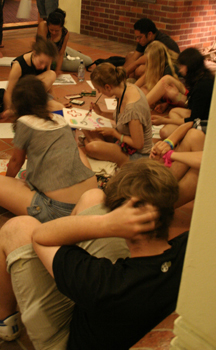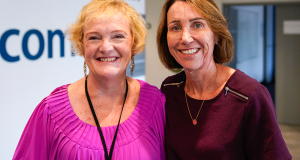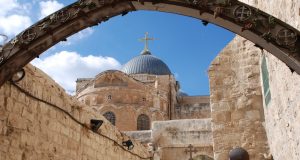
FOR MANY years emotional experiences evoked by sense and touch and have been used to create a different style of worship.
Known as alternative worship, it is used by Christian churches all over the world including, possibly its best known proponents, the Taizé Community.
Cheryl Lawrie is the co-director of the Culture and Context Unit of the Synod of Victoria and Tasmania.
She has explored alternative worship techniques for many years.
Through alternative worship she aims to facilitate spaces for people to discover a moment of transformation and grace.
“The primary theology around alternative worship is that God speaks into and from within all cultures – so alternative worship uses the things of the community’s everyday lives (images, music, language) to hear and respond to the story of God,” she said.
“The Modern period was so rational and very word-based and our worship reflected that, so worship was based around the spoken word.
“We would often give people a meaning that they needed to hear from worship.
“Alternative worship tries to offer people an experience which, hopefully, will not discount the rational but recognises that rarely are people changed by words.
“Transformation doesn’t happen because you are convinced about something or you are talked into it.
“It is an encounter where you experience a story that resonates with your own.
“In some ways we’re rediscovering ancient practices and patterns of liturgy and ritual that invite people into faith and go beyond reason and understanding.
“We’re trying to work with those people for whom words aren’t their primary means of understanding the world or themselves.
“Art and music and tactile things often reach a different part of people’s minds and souls that words won’t.”
A sense of community remains at the core of alternative worship.
“It holds fast to the belief that liturgy is not the work of the minister, but the work of the people,” she said.
“It’s scary because it means we give up any illusion of control in terms of what message people hear.
“Because we’re looking first to tell a story (not its meaning) it means that more people have the capacity to be involved.
“And it doesn’t mean they have to be Christian to do it.
“Within my primary community many of the people who put together spaces wouldn’t identify themselves as Christian,
but in curating worship together there’s space for everyone to bring their story and put it against a story of Christian faith,
to find where it rubs against us and where it resonates.”
Ms Lawrie stressed that alternative worship is not for everyone; it is an alternative to evoke a transformation, and she admits there is no way of knowing what will work.
“I don’t have the right to know what someone else needs to get from worship, that is between them and God, all I can do is curate a space where people might be able to have a transforming moment.”
And she said it was extraordinary to see someone changed in that way.
“It is incredibly humbling,” she said. “You see people come into a space and go away changed and you think, ‘what right did I ever have to think that I might mediate that?’
“I see people encounter something that is so transforming and beyond human making.
“Something amazing happens when people get to put their story against the bigger story of life and I’ve never been let down when we have done that.”
One of Ms Lawrie’s great joys is the worship she facilitates in prisons over Easter each year.
“On Easter Saturday we have an afternoon vigil.
“The premise is that if this is the day Christians believe God has gone to hell, which is in our creeds … then maybe there is a chance that Jesus will be in this hell.
“None of it is hopeful or offers the promise of resolution, it purely offers the chance of people telling their story of being in hell, and everybody has that moment of absolute abandonment, fear and horror.
“Something extraordinary happens when you let people have that story and when you say this is God’s story too.
“It is the easiest thing to do.
“You buy pieces of black card and put A3 colour images on them and invite people to write their reflections on them in
black pen, or white pen if you are courageous.”
It is these simple ideas that Ms Lawrie said people could try in their own communities.
“Alternative worship can look so intimidating to anybody who wants to try it.
“They think ‘I can’t do multiscreen projections and make my own movies or music’.
“Neither can I.
You start with what you can do and you tweak things from other places and work out of the creative base of people in your community.
“It is a group of people who aren’t saying ‘this is what somebody else needs to hear’, but ‘this is how I need to encounter this story’.
Photo : Alternative worship in action at ncyc11. Photo by Jane Moad
 JourneyOnline
JourneyOnline






